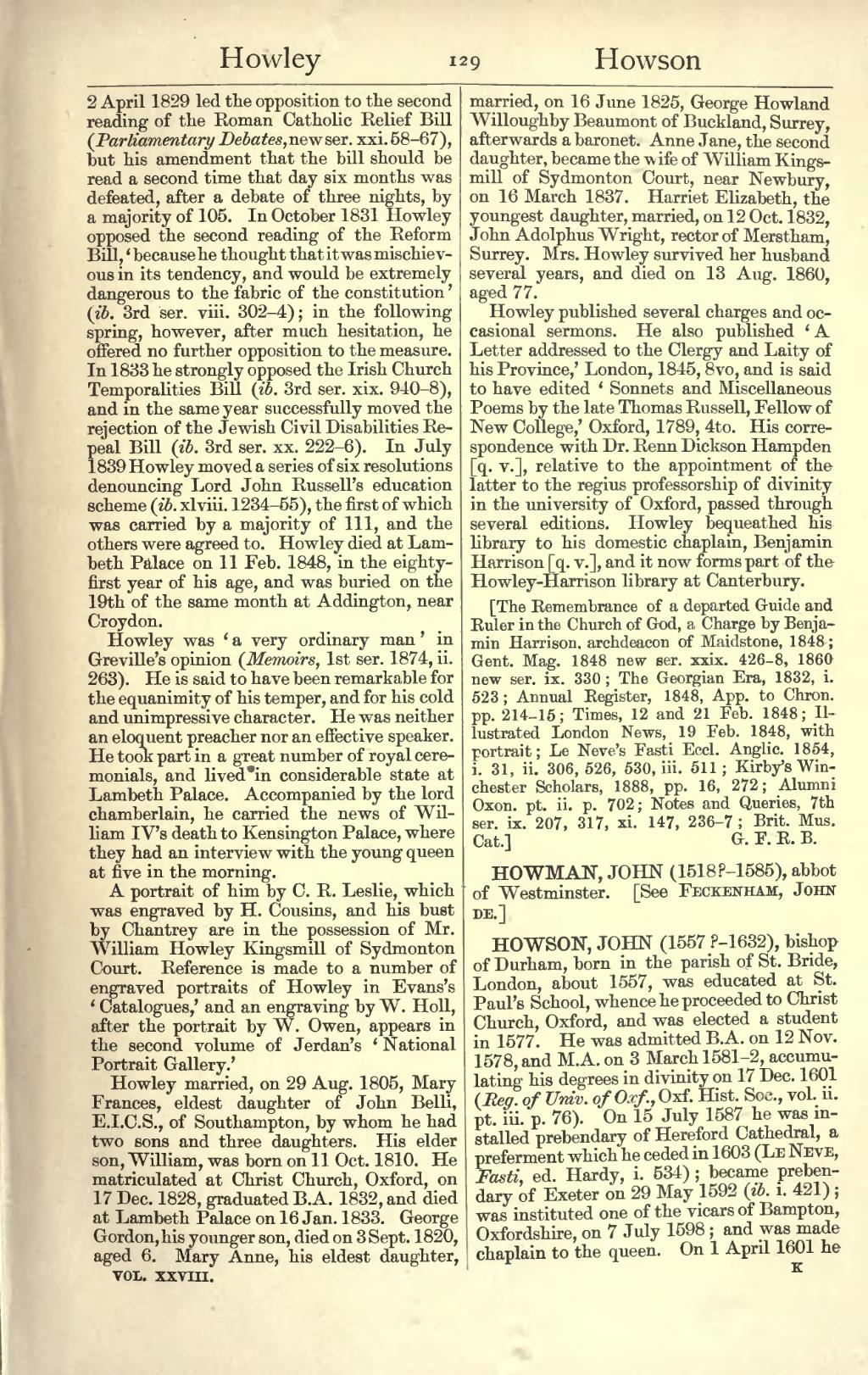2 April 1829 led the opposition to the second reading of the Roman Catholic Relief Bill (Parliamentary Debates, new ser. xxi. 58-67), but his amendment that the bill should be read a second time that day six months was defeated, after a debate of three nights, by a majority of 105. In October 1831 Howley opposed the second reading of the Reform Bill, 'because he thought that it was mischievous in its tendency, and would be extremely dangerous to the fabric of the constitution' (ib. 3rd ser. viii. 302-4); in the following spring, however, after much hesitation, he offered no further opposition to the measure. In 1833 he strongly opposed the Irish Church Temporalities Bill (ib. 3rd ser. xix. 940-8), and in the same year successfully moved the rejection of the Jewish Civil Disabilities Repeal Bill (ib. 3rd ser. xx. 222-6). In July 1839 Howley moved a series of six resolutions denouncing Lord John Russell's education scheme (ib. xlviii. 1234-55), the first of which was carried by a majority of 111, and the others were agreed to. Howley died at Lambeth Palace on 11 Feb. 1848, in the eighty-first year of his age, and was buried on the 19th of the same month at Addington, near Croydon.
Howley was 'a very ordinary man' in Greville's opinion (Memoirs, 1st ser. 1874, ii. 263). He is said to have been remarkable for the equanimity of his temper, and for his cold and unimpressive character. He was neither an eloquent preacher nor an effective speaker. He took part in a great number of royal ceremonials, and lived in considerable state at Lambeth Palace. Accompanied by the lord chamberlain, he carried the news of William IV's death to Kensington Palace, where they had an interview with the young queen at five in the morning.
A portrait of him by C. R. Leslie, which was engraved by H. Cousins, and his bust by Chantrey are in the possession of Mr. William Howley Kingsmill of Sydmonton Court. Reference is made to a number of engraved portraits of Howley in Evans's 'Catalogues,' and an engraving by W. Holl, after the portrait by W. Owen, appears in the second volume of Jerdan's 'National Portrait Gallery.'
Howley married, on 29 Aug. 1805, Mary Frances, eldest daughter of John Belli, E.I.C.S., of Southampton, by whom he had two sons and three daughters. His elder son, William, was born on 11 Oct. 1810. He matriculated at Christ Church, Oxford, on 17 Dec. 1828, graduated B.A. 1832, and died at Lambeth Palace on 16 Jan.1833. George Gordon, his younger son, died on 3 Sept. 1820, aged 6. Mary Anne, his eldest daughter, married, on 16 June 1825, George Howland Willoughby Beaumont of Buckland, Surrey, afterwards a baronet. Anne Jane, the second daughter, became the wife of William Kingsmill of Sydmonton Court, near Newbury, on 16 March 1837. Harriet Elizabeth, the youngest daughter, married, on 12 Oct. 1832, John Adolphus Wright, rector of Merstham, Surrey. Mrs. Howley survived her husband several years, and died on 13 Aug. 1860, aged 77.
Howley published several charges and occasional sermons. He also published 'A Letter addressed to the Clergy and Laity of his Province,' London, 1845, 8vo, and is said to have edited 'Sonnets and Miscellaneous Poems by the late Thomas Russell, Fellow of New College,' Oxford, 1789, 4to. His correspondence with Dr. Renn Dickson Hampden [q.v.], relative to the appointment of the latter to the regius professorship of divinity in the university of Oxford, passed through several editions. Howley bequeathed his library to his domestic chaplain, Benjamin Harrison [q.v.], and it now forms part of the Howley-Harrison library at Canterbury.
[The Remembrance of a departed Guide and Ruler in the Church of God, a Charge by Benjamin Harrison, archdeacon of Maidstone, 1848; Gent. Mag. 1848 new ser. xxix. 426-8, 1860 new ser. ix. 330; The Georgian Era, 1832, i. 523; Annual Register, 1848, App. to Chron. pp. 214-15; Times, 12 and 21 Feb. 1848; Illustrated London News, 19 Feb. 1848, with portrait; Le Neve's Fasti Eccl. Anglic. 1854, i. 31, ii. 306, 526, 530, iii. 511; Kirby's Winchester Scholars, 1888, pp. 16, 272; Alumni Oxon. pt. ii. p. 702; Notes and Queries, 7th ser. ix. 207, 317, xi. 147, 236-7; Brit. Mus. Cat.]
HOWMAN, JOHN (1518?–1585), abbot of Westminster. [See Feckenham, John de.]
HOWSON, JOHN (1557?–1632), bishop of Durham, born in the parish of St. Bride, London, about 1557, was educated at St. Paul's School, whence he proceeded to Christ Church, Oxford, and was elected a student in 1577. He was admitted B.A. on 12 Nov. 1578, and M.A. on 3 March 1581-2, accumulating his degrees in divinity on 17 Dec. 1601 (Reg. of Univ. of Oxf. Oxf. Hist. Soc., vol. ii. pt. iii. p. 76). On 15 July 1587 he was installed prebendary of Hereford Cathedral, a preferment which he ceded in 1603 (Le Neve, Fasti, ed. Hardy, i. 534); became prebendary of Exeter on 29 May 1592 (ib. i. 421); was instituted one of the vicars of Bampton, Oxfordshire, on 7 July 1598; and was made chaplain to the queen. On 1 April 1601 he
